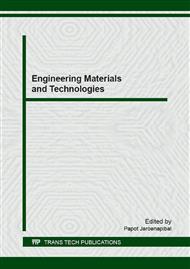[1]
A. Benmarouane, T. Hansen, A. Lodini, Heat treatment of bovine bone preceding spatially resolved texture investigation by neutron diffraction, Phys B Condens Matter. 350 (2004) 611–614.
DOI: 10.1016/j.physb.2004.03.163
Google Scholar
[2]
T. Arahira, M. Maruta, S. Matsuya, M. Todo, Development and characterization of a novel porous β-TCP scaffold with a three-dimensional PLLA network structure for use in bone tissue engineering, Mater Lett Elsevier. 152 (2015) 148–150.
DOI: 10.1016/j.matlet.2015.03.128
Google Scholar
[3]
Y. Xu, D. Wang, L. Yang, H. Tang, Hydrothermal conversion of coral into hydroxyapatite, Mater Charact. 47 (2001) 83–87.
Google Scholar
[4]
K.S. Vecchio, X. Zhang, J.B. Massie, M. Wang, C.W. Kim, Conversion of bulk seashells to biocompatible hydroxyapatite for bone implants, ActaBiomater. 3 (2007) 910–918.
DOI: 10.1016/j.actbio.2007.06.003
Google Scholar
[5]
R. Murugan, S. Ramakrishna, R. K. Panduranga, Nanoporoushydroxy-carbonate apatite scaffold made of natural bone, Mater Lett. 60 (2006) 2844–2847.
DOI: 10.1016/j.matlet.2006.01.104
Google Scholar
[6]
E.M. Rivera, M. Araiza, W. Brostow, Castaño VM, Díaz-Estrada JR, Hernández R, Synthesis of hydroxyapatite from eggshells, Mater Lett. 41 (1999) 128–134.
DOI: 10.1016/s0167-577x(99)00118-4
Google Scholar
[7]
T. Laonapakul, Synthesis of hydroxyapatite from biogenic wastes, KKU En J. 42 (2015) 269-275.
Google Scholar
[8]
M.M. Hassaan, H.M. Khater, M M. Ahllawy, Production of geopolymer composites enhanced by nano-kaolin material, J Adv Ceram. 4(4) (2015) 245–252.
DOI: 10.1007/s40145-015-0156-y
Google Scholar
[9]
J. Davrdovrts, Geopolymer: Room-temperature ceramic matrix for composites. In: Proceedings of the 12th Annual Conference on Composites and Advanced Ceramic Materials, Part 1 of 2: Ceramic Engineering and Science Proceedings, John Wiley & Sons, Inc., (2009).
DOI: 10.1002/9780470310496.ch34
Google Scholar
[10]
S. Pangdaeng, V. Sata, J.B. Aguiar, T F. Pacheco, P. Chindaprasirt, Apatite formation on calcined kaolin-white Portland cement geopolymer, Mater SciEng C. 51 (2015) 1-6.
DOI: 10.1016/j.msec.2015.02.039
Google Scholar
[11]
M. Catauro, F. Bollino, F. Papale, G. Lamanna, Investigation of the sample preparation and curing treatment effects on mechanical properties and bioactivity of silica rich metakaolin geopolymer, Mater SciEng C. 36 (2014) 20–24.
DOI: 10.1016/j.msec.2013.11.026
Google Scholar
[12]
N.J. Coleman, J.W. Nicholson, K. Awosanya, A preliminary investigation of the in vitro bioactivity of white Portland cement, Cem Concr Res. 37 (2007) 1518–1523.
DOI: 10.1016/j.cemconres.2007.08.008
Google Scholar
[13]
P. Leelatawonchai., T. Laonapakul, Synthesis of calcium phosphate based bioceramics from golden apple snail shell through dry Methods. IE network conference; 2015, Bangkok: (2015).
DOI: 10.4028/www.scientific.net/amr.931-932.370
Google Scholar
[14]
Annual Book of ASTM Standard (2005), p.76–81.
Google Scholar
[15]
T. Kokubo, H. Takadama, How useful is SBF in predicting in vivo bone bioactivity Biomaterials. 27 (2006) 2907–2915.
DOI: 10.1016/j.biomaterials.2006.01.017
Google Scholar
[16]
J. Djobo, L.N. Tchadjié, H.K. Tchakoute, B. Kenne, A. Elimbi, D. Njopwouo, Synthesis of geopolymer composites from a mixture of volcanic scoria and metakaolin. J Asian Ceram Soc. 2 (2014) 387–398.
DOI: 10.1016/j.jascer.2014.08.003
Google Scholar
[17]
J. Tailby, K. Mackenzie, Structure and mechanical properties of aluminosilicate geopolymer composites with Portland cement and its constituent minerals, CemConcr Res. 40 (2010) 787-794.
DOI: 10.1016/j.cemconres.2009.12.003
Google Scholar
[18]
C.Y. Heah, H. Kamarudin, A. Mustafa, M. Binhussain, M. Luqman, N. I Khairul, Effect of curing profile on kaolin-based geopolymers, Phys Procedia. 22 (2011) 305–311.
DOI: 10.1016/j.phpro.2011.11.048
Google Scholar
[19]
S. Jalota, S.B. Bhaduri, A.C. Tas, In vitro testing of calcium phosphate (HA, TCP, and biphasic HA-TCP) whiskers, J Biomed Mater Res - Part A. 78(3) (2006) 481-491.
DOI: 10.1002/jbm.a.30851
Google Scholar
[20]
X. Lu, Y. Leng, Theoretical analysis of calcium phosphate precipitation in simulated body fluid, Biomaterials. 26 (2005) 1097–108.
DOI: 10.1016/j.biomaterials.2004.05.034
Google Scholar
[21]
T. Laonapakul, N. A. Rakngarm, Y. Otsuka, Y. Mutoh, Failure behavior of plasma-sprayed HAp coating on commercially pure titanium substrate in simulated body fluid (SBF) under bending load, J Mech Behav Biomed Mater. 15 (2012) 153-166.
DOI: 10.1016/j.jmbbm.2012.05.017
Google Scholar


